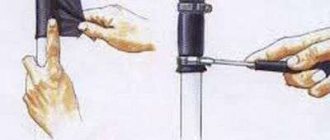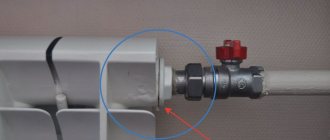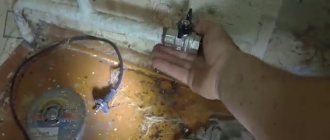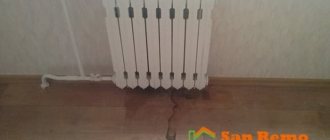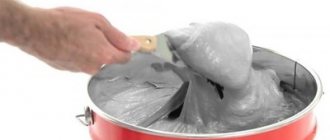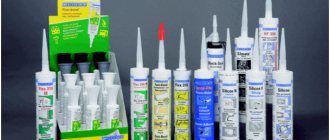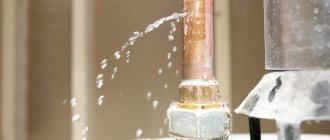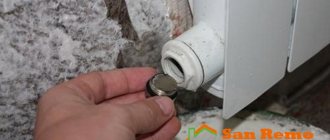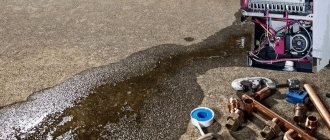A heating system leak is not uncommon, and in most cases it happens unexpectedly, except for test runs of equipment at the beginning of the heating season. It is not always possible to determine reliably what caused the leak, and this is not always important, since restoring the tightness of the heating circuit is in the foreground in such situations. As a rule, major repairs are postponed until the warm season, and when a leak is detected, they choose what to temporarily cover up the leak in the heating pipe.
How to seal a leak
In connection, on threads and joints
All heating elements are assembled into a single system using threaded, welded, soldered and fitting connections.
Any of them is the least reliable place and it happens - they leak. Leaks in pipe joints, whether metal or polypropylene, can be eliminated using epoxy resin-based glue. To do this, the surface of the metal pipe along with any damage must be cleaned of old paint and rust. You can clean it with a wire brush, sandpaper, or scrape it off with a knife. Prepare fiberglass or medical bandage. If the pipe has a diameter of 15 to 32 mm, the length of the fabric is approximately 30-35 cm. Then add a hardener to the glue base in the proportion specified in the instructions. You can add more hardener to increase the hardening speed. The main thing is not to overdo it, otherwise you won’t have time to finish before the glue hardens. Soak the fabric with glue and wrap the damaged area. Once hardened, the heating can be started. Work with rubber gloves. Leaks at the joints of polypropylene pipes can be eliminated in the same way.
Most often, threaded connections of the radiator and pipes leak. In these places and at the joints, in addition to epoxy glue, cold welding and cement-plaster dressings can be used. The method is old, but quite workable. Ready-made dressings are rarely found on sale. Therefore, they are prepared independently. Cement is mixed with alabaster (construction gypsum) in a ratio of 1 to 0.5, diluted with water to a thick rustic sour cream, the bandage is cut into strips of 30-35 cm, and placed in a container with cement-gypsum mortar, then soaked, applied in layers over the threaded connections, cover the top with the remaining solution. Sometimes salt is added to the composition.
In the radiator and pipes
There are damages in the radiator sections. It is often not possible to repair a hole in a radiator without dismantling it. It can only be sealed where there is access. If you are lucky and the hole is accessible, you can seal it using a roofing screw, bolt or chopper. Well, everything is clear with the chopper, sharpen it and hammer it into the hole, carefully cut off the excess.
If there is a large hole in the battery, you can install a bolt. To do this, you need to drill a hole and cut the thread using a tap and dip the body of the bolt in paint and screw it into place. This is easy to do only on paper, in reality everything is much more complicated. The same methods can be applied to pipe repair. If the pipe is thick-walled (3 mm or more)
Between battery sections
Leaks between battery sections can be eliminated if it is cast iron. For aluminum and bimetallic ones, the sections are located very close and it is impossible to get there.
Repair using cold welding or epoxy glue; in addition, a narrow clamp can be installed over the adhesive bandage or cold welding. It will press everything underneath it against the body of the battery. Heat-resistant sealant can also be used in combination with the clamp.
Hidden wiring
Hidden, this is part of the heating system, which is covered with a concrete floor screed, insulation or decorative boxes. In all these cases, the most difficult thing is to find and get to the place of damage. And after that, evaluate which repair method to choose. There is no way without professionals.
On a straight section
On straight and accessible sections, you can use any method that you like best and works better. But the most reliable method will be the mechanical method using clamps or bandages.
Fixing a leak in a heating pipe without draining the water
What to do in this case if it is necessary to eliminate the leak? After all, in this case, cold welding will not help. There is a way out - this is the same “stub” discussed above. The material impregnated with the sealant is able to adhere even to a wet surface.
The mixture can be purchased at a hardware store. Wipe the surface of the pipe dry, and then wrap a cloth with sealant. This method of repair helps with minor digging.
If the leak in the pipe gets worse, use a piece of rubber as a temporary seal. For example, cut the required size from a bicycle or car tube. There should be a piece in reserve.
Wrap the prepared rubber tightly around the area where the crack is observed. For fixation, it is advisable to use one worm clamp or several pieces. You can use car clamps that are designed to connect pipes. Press down the rubber gasket with a clamp and screw it in with a screwdriver. This simple method will help eliminate the leak or reduce it slightly.
At the hardware store, you can purchase ready-made kits for repairing pipes in the event of a leak. It includes a prepared clamp with a rubber gasket and a small valve. Thanks to it, it is possible to drain accumulated water from under the clamp while installation is taking place.
After the clamp is securely fixed, the valve closes tightly and the flow stops. Such kits for repairing heating and other types of pipes help prevent an undesirable situation in the event of severe leakage. Other means are unlikely to save you.
In addition, if it is not possible to drain the water from the heating system, you can use another simple method. Using a special product, dry and freeze the section of pipe with the crack, and then seal it with glue or sealant.
The most relevant means are “Apparatus Moroz”, “FREEZE PACK” and others. Such treatments help to freeze the water in the damaged heating pipeline. At this moment, the water pressure in the damaged area decreases, which makes it possible to cut out a piece of pipe and weld a new one. You can also apply a “plug” to this area.
It is necessary to understand that the methods presented in our material for eliminating leaks in pipes using cold welding, sealant, adhesive, and ready-made repair kits are just a temporary measure. Over time, the crack will widen, rust may reappear and the leak will resume.
It is advisable to do a thorough repair of pipes in the summer, namely, drain the water and completely replace the area with a crack or rust. If this is not done, then in winter you can again expect unpleasant surprises. It is best to invite specialists for repair work.
The essence of the cold welding method
The idea proposed by the inventors of this method of connecting parts is quite simple. The composite material is thoroughly mixed, after which complex chemical reactions are launched, imparting new properties to the mixture. Over time, the soft composition hardens, penetrates the structure of the materials being bonded and becomes comparable in strength to metal surfaces.
Excellent performance characteristics make it possible to use cold welding to solve a wide range of household problems:
- Elimination of leaks in metal and polymer water-pressure structures.
- Sealing cracks in heating radiators.
- Sealing places of damage to metal elements of the car body.
- Strengthening problem areas of pipeline networks.
The material can become indispensable in situations where the problem section of the pipeline is in a hard-to-reach place, where, even if you wanted to, it would not be possible to use a welding machine or other bulky device.
Heating radiator leaking
If you find a leak in the heating battery itself, you can plug the hole using a simple self-tapping screw. This is done to reduce the flow of water, which will make it easier to carry out subsequent repair work, even if the taps are not turned off.
If a hole forms in the joint of the heating radiator, the problem is eliminated using a piece of fabric glued with epoxy. They wrap it around the damaged area. The leak has been fixed and you can rest easy until the end of the season.
By using a thick piece of fabric, electrical tape, tape and salt, you can also eliminate a leak in the heating battery:
- pour salt onto a cloth and wrap the damaged area;
- We secure everything with tape.
If the leak is not found, you should temporarily turn off the taps of the heating system, remove the battery, and lower it into a container of water. Then we determine the damaged area by the place where the air passes through. A sealant is used for repairs. After filling the damaged area, we additionally apply a fabric wrap and attach the heating radiators back.
Typically, at the top of the heating radiator there are air release valves that can be used during its operation. After the end of the operating season, the heating radiator or its damaged sections are replaced with new ones.
If a section of the radiator is leaking, the same procedure is followed as for a radiator leak.
Radiators and heating pipes can be either plastic or aluminum; they are a little more difficult to repair, and special skills are required to eliminate leaks in them. If a cast iron battery leaks, then cold welding will be required to repair it.
It is necessary to worry in advance about the availability of the necessary materials for repairing the heating system, and to repair everything more thoroughly after the end of the heating season.
Common mistakes
You can’t skimp on clamps and install narrow ones. Remember, the clamp should cover the pipe with a margin of 2-3 cm on each side of the fistula, because on the inside the damage can be much greater.
Do not grab the pipe wrench and do not try to tighten the “current” threads; on old pipes, break them off.
You can’t work with an angle grinder and clean out fistulas; you’ll rupture them and get a flood. In general, power tools and water are a very dangerous pair. Do not try to fix a leak in a pressurized system, especially in apartment buildings, with anything other than a clamp or bandage.
The most common mistake is underestimating the situation, excessive self-confidence and haste. Most men can do everything else.
Be careful and careful.
In conclusion, let us remind you once again that all the repairs listed above are a temporary solution to the problem. Necessary in order to survive until the end of the heating season and begin repairs with the replacement of pipes and worn-out appliances. Repairers say “a small fistula is a harbinger of a big repair”
Preventing Leaks
In order to prevent the formation of leaks in sewer, plumbing and heating systems, you should follow the simple recommendations of specialists:
- do not allow the drain pipeline to become clogged;
- make sure that condensation does not form on the cold riser;
- freezing of the external pipeline is unacceptable;
Each of the proposed solutions to the problem does not cause technical difficulties. The only exception is a malfunction of the metal or plastic system on the drains. In this case, simply covering up the damaged area will not work; this will require the help of specialists and the use of equipment.
Pipe connection is leaking
Leaks at pipe joints can be eliminated using the same homemade or factory-made clamps. If there is a difference in diameter, you can first wind the rubber band and then make or put on a clamp.
If the connection is threaded and drips from under the winding, you can pour alcohol onto the tow and then spread it with BF glue. It is alcohol soluble. Once on the alcohol-contained tow, it liquefies and can flow into the joint. Then, when the alcohol evaporates, the glue dries, and the “drops” stop. But this method only works if you have “drops” and not a “fountain”. And one more thing: such a processed connection is then very difficult to disassemble.
If it is possible to stop the system or disconnect the radiator (if there is a leak at the junction with it), it is better to repack the threaded connection. To do this, carefully and slowly unscrew the nut (lock nut). It needs to be turned away and then wrapped. Don’t make significant efforts - there is a high chance of breaking it, and then you will definitely have to stop the system and redo everything. After tightening the nut, remove all the tow or fum tape, remove any remaining sealant, and in general, thoroughly clean the threads. Wipe it until clean, you can treat it with a degreaser (acetone or pure gasoline).
If it leaks under the locknut, it can be repacked
Please note that there is no excess tow - just a little, and paste on top. Take the winding and paste (sealant), wind the flax and coat everything with paste
Now you can twist it. First with your hand, then with a key. But here you also need to work carefully: it’s very easy to break the thread. Therefore, hold the key not by the edge, but in the middle - it’s easier to calculate the effort. Don’t overdo it with the amount of tow either. If cast iron, in principle, does not matter how much winding you wind, then aluminum and bimetallic, as well as steel, can crack from a large amount. A microcrack first appears in the collector, into which water leaks. The metal corrodes, the paint swells, a section (or the entire radiator) is damaged
Take the winding and paste (sealant), wind the flax and coat everything with the paste. Now you can twist it. First with your hand, then with a key. But here you also need to work carefully: it’s very easy to break the thread. Therefore, hold the key not by the edge, but in the middle - it’s easier to calculate the effort. Don’t overdo it with the amount of tow either. If cast iron, in principle, does not matter how much winding you wind, then aluminum and bimetallic, as well as steel, can crack from a large amount. A microcrack first appears in the collector, into which water leaks. The metal corrodes, the paint swells, a section (or the entire radiator) is damaged.
But this is all in cases where the threaded connection is leaking. If a fitting under a press (metal-plastic pipes) has leaked, you can try to simply tighten it. In the case of copper pipes, only soldering will work. If there is a leak at the junction of polypropylene pipes, there is also only one option - cut out the damaged piece and weld a new one.
It doesn't matter what you use. The result is important
Classification
This material can be single-sided or double-sided and can be used to work in different temperature conditions and with different materials. Before purchasing tape for specific jobs, read the instructions for use. Insulating tape for sealing water pipes comes in the following types: butylene, bitumen-polymer, roofing and polycarbonate.
Tapes of various classes can be used not only during construction and repair work, but also when working with vehicles, in the oil and gas industry, and is also used in domestic conditions. This material can be used both to eliminate leaks and when installing electrical networks to create a waterproof layer.
Joint sealing tapes
In cases where it is necessary to ensure a high-quality connection of a thread or flange, in addition to the use of surface tape, internal plumbing tape is used. It is thinner and has other technical and operational properties. Such sealants include the brands “K-Flex”, “FUM”, “Record”. There is also a special composition in the form of a gel, which allows for additional compaction and sealing of connections.
Thread sealers can be used to work with pipelines of various classes. They help eliminate leaks of natural and liquefied gas, drinking and industrial water, and various antifreezes. They are used by plumbers, gas workers and even car mechanics.
Thread sealing tape can be used in conjunction with surface insulation.
Butylene
This type of sealant can work in a wide range of temperatures - from -60 to +120 degrees Celsius. Butylene tape is suitable for repairing leaks in water pipes and when working with gas pipes. It consists of a butyl rubber mixture, so it has excellent contact with almost any material. It can also be used when working with polyvinyl chlorides. Butylene is able to withstand exposure to ultraviolet radiation, acids, alkalis and does not emit any odor.
Bitumen-polymer
An airtight material that can be used to seal imperfect, rough and uneven surfaces. This material not only provides high-quality sealing of seams and pipeline connections, but is also capable of sealing itself in case of damage. This feature allows the tape to be used to provide dielectric and anti-corrosion protection. It is also suitable for connecting joints, including connectors with flange and thread.
Fum tape
Explanation of the abbreviation FUM - Fluoroplastic Sealing Material. The most popular type of sealant for improving the sealing of water and gas pipes. Used inside threads, sometimes applied over joints. This pipe tape is distributed in the form of rolls of white color, resembling electrical tape, 1-2 centimeters wide. Fumka or fum tape is divided into several categories, depending on the technical characteristics and composition:
- for use in aggressive environments – withstands and withstands the effects of acid, alkali, natural and liquefied gas;
- for oxygen - since this gas leads to rapid corrosion, innovative compounds are used to seal oxygen-conducting pipelines that can withstand the aggressive environment of this chemical element;
- for domestic needs - withstands aggressive environments, which are not uncommon in a private home, produced for domestic use.
How to fix a pipe body leak
How to repair a leak in a pipe if there is a crack in the body? To resolve the problem, you can use one of the following methods:
- install the clamp;
- apply a bandage;
- use cold welding.
Installation of the clamp
The easiest way to eliminate a leak on the pipe body is to install a repair clamp. The special device consists of:
- metal case;
- rubber seal located inside the housing;
- fixing bolts.
Special device for eliminating pipe leaks
You can install the clamp yourself in the following way:
- the leak site is cleaned of dust and rust;
- the pipe is wrapped with a clamp;
- The device is fixed.
Eliminating leaks using a clamp
Applying a bandage
How to seal a leaking pipe if there is no clamp? To eliminate a leak, you can use a rubber, adhesive or cement bandage.
The rubber bandage is:
- piece of rubber. A cut from a bicycle inner tube or a medical tourniquet used to stop bleeding is ideal. Use a rubber cut to wrap around the cracked section of the pipe;
- small clamps, wire or other fastening straps for securing the rubber to the pipe.
Pipe bandage made from scrap materials
The adhesive bandage is installed according to the following scheme:
- the section of the pipe where the leak has occurred is cleaned of dirt using a solvent;
- fiberglass or medical bandage is impregnated with special glue;
Special composition for eliminating leaks
- the pipe is wrapped in prepared material in several layers;
Installing an adhesive bandage at the leak site
Watch the video to see how to cover a leaking pipe with epoxy resin.
A cement bandage is an analogue of an adhesive bandage. The bandage or fiberglass is impregnated with cement mortar prepared in a ratio of 1:10.
Cold pipe welding
A relatively new way to eliminate leaks is to use a so-called cold welding composition. How to coat a pipe to prevent it from leaking? For different types of pipes (metal, plastic, metal-plastic, and so on), different cold welding compositions are used.
Composition for various types of plastic pipes
Detailed instructions for using the mixture are given on the bottle with the active substance. Here is the general algorithm:
- Before applying the mixture, the damaged section of the pipeline is cleaned of dirt. If the composition needs to be applied to a metal pipe, then the crack is additionally cleaned of paint and rust;
Cleaning the pipe before cold welding
- A special composition is applied to the damaged area. If liquid cold welding in the form of glue is used, it is advisable to apply it with a brush. If a plasticine-like composition is used, then before application it is necessary to knead it thoroughly until a homogeneous mixture is obtained;
- the cold welding substance is evenly distributed throughout the entire area of the cracked pipeline, covering 3–4 cm more than the crack itself;
Coating the damaged area with a cold welding substance
- the composition is left until completely dry, which takes an average of 2.5 - 3 hours.
All methods given in the article for eliminating leaks on the pipe body, except for the use of cold welding, are only a temporary measure. To completely get rid of the problem, it is necessary to completely replace the damaged section of the pipeline. It is advisable to involve qualified specialists to perform this operation.
Sealing tapes
These innovative products have anti-corrosion properties. They consist of a bitumen-rubber base with the addition of a layer of aluminum (or copper). The greatest efficiency of using self-adhesive tapes is achieved when sealing the joints of sewer structures.
Positive characteristics of sealing tapes:
- ease of use;
- strength;
- long operational period;
- providing dielectric and anti-corrosion protection of pipes.
The only drawback of the material is rapid deterioration when exposed to sunlight. This “minus” of the product does not in any way affect the elimination of pipe defects. Indeed, in most cases, the sewer system is located away from exposure to ultraviolet radiation. If the pipes are located in an open space, then when sealing holes and cracks, the self-adhesive tape is additionally covered with a protective material.
The process of using tape consists of the following steps:
- the damaged surface is cleaned of dirt and dust;
- after the surface has dried, the protective film is removed from the tape;
- the tape is wrapped around the pipe.
The tape is wrapped in a spiral with an overlap of up to 50%. As a result, the entire pipe will be covered with two layers of material. When tensioning the tape, it is necessary to avoid the appearance of wrinkles.
How to fix a leak in a heating pipe
Methods for eliminating leaks in heating pipes depend on a number of factors:
- the material from which the pipe is made;
- location of the leak (flat area or junction).
The best way to fix a leak is to call a specialist who can fix all the problems. If this cannot be done for some reason, then there are other methods by which you can repair the pipe yourself.
Many have already dealt with the question of why a leak may form in a heating pipe. There are several ways to fix this common defect.
If the leak occurs on a flat section of the pipe, then you need to determine the location of the damage. Then place a piece of rubber larger than the hole on this place and tighten the entire structure with soft wire. There are ready-made materials for this procedure on sale.
If a leak appears at the junction of the heating pipe with the radiator or tap at the threaded connection, then in this case the task becomes somewhat more complicated. Pipes of different diameters can be located at the junction points.
You can also wrap a long piece of soft rubber around the leak and use a clamp to compress the damaged section of the pipe. This option is not the final way to eliminate the breakdown, since the connection point must be disassembled and, if necessary, remade. And this can only be done with the heating system turned off.
In a city apartment, you still need to call a specialist for this, but in a private house, with an autonomous system, you can do it yourself. Therefore, before the heating season, just in case, it is necessary to have spare parts or new couplings for connecting pipes.
If the cause of a leak in a heating pipe is a pressure difference in the coolant, then in this case it is necessary to eliminate this problem.
Due to the fact that the heating system uses pipes of different diameters, water hammer may occur, especially when the owner of an apartment or house tries to bleed air from the system. To eliminate this problem, it is necessary to create special expansion devices or compensation loops.
If a leak occurs between sections of the heating radiator, you can temporarily wrap this area with thick fabric, which is impregnated with sealant or moisture-resistant glue. When the glue dries, you can turn on the radiator. Then you should definitely invite a specialist to completely eliminate the leak.
You can use a special sealant for heating pipes “cold welding”. As the name suggests, this material has high drying strength. Therefore, this sealant is often used for repairs in heating systems and even in the repair of car radiators.
Sealant Cold welding
All methods for eliminating leaks in heating pipes are good. However, they are temporary. Only a specialist can completely eliminate all the causes.
When is it necessary to repair your heating system?
Naturally, major repairs of the entire heating system must be carried out in a timely manner before the onset of the cold season. If the heating pipe drips in winter, this means that appropriate measures were not taken in summer.
If the heating system was installed a long time ago and using steel pipes, then it’s time to think about replacing the metal elements of the system with reinforced polypropylene pipes. Recently, German REHAU plastic pipes, which are leaders in reliability and durability, have become popular. They are adapted to heating systems in our country and if installed correctly, heating pipes will not leak.
All plastic products are not subject to corrosion and have a high degree of strength. Therefore, replacing old worn-out metal pipes is necessary. Patching holes will not lead to a sufficient level of comfort, because every year more and more damage will occur.
It is much easier and cheaper to repair and replace heating systems and communications in the summer, when the heating system is turned off. All work must be carried out in a timely manner, otherwise in winter during severe frosts you will have to turn off the heating in the house.
Signs of depressurization
The heating systems are all built according to the same scheme - boiler - supply pipes - appliances - return pipes - boiler. It's looped. The pressure and circulation of the coolant in central heating systems is maintained using pumps. In private sector houses with an autonomous open heating system, pressure and circulation are provided by the boiler when heating. The cottages have an autonomous closed heating system, the coolant is always under pressure.
In heating systems, pressure control occurs using instruments, but small leaks are still difficult to detect; automation equalizes a slight drop in pressure. Pressure gauges are not installed in private houses. Therefore, in both cases, residents have only one way to control the tightness - visually.
When inspecting heating appliances and pipes suitable for them, pay attention to damp places. In areas of obvious leaks, water will drip or flow, leaving traces of rust. But those who hid metal risers in boxes that one of them is leaking will most likely find out from the neighbors to whom the water flowed
Leakage at joints
If the heating battery is leaking, what to do and how to fix this problem?
First you need to determine the cause, find out why the pipes are leaking.
Leaks in joints can occur for 2 reasons:
- loose connection of threaded connections;
- pipe body cracked.
Let's consider what to do in such a situation and how to seal leaks at the joints. To do this you will need the following materials:
- rubber tubes;
- wire;
- materials for similar welding - sealants;
- several fasteners, clamps;
- rubber bandage.
First, using a rubber bladder, we block the leak and fix it using 3 clamps or iron wire. We close the leak with one clamp, place the other 2 along the edges of the chamber, or use a plumbing bandage, which is also a thick piece of rubber attached to the pipe with a clamp. It is bolted together to provide a seal.
If a leak occurs at the junction of the pipe and the battery, tie a piece of rubber to the detected leak. We secure it with clamps directly at the leak site and on the pipe itself. A factory bandage or tube rubber can also be used here.
In such cases, cold welding can be used. It is performed using a sealant, which, after kneading, is applied to the damaged area, pressed firmly and smoothed. Hardening occurs within 3 hours.
Regularly, at least once a year, in the summer, it is worth calling a specialist to thoroughly inspect the entire system and replace parts in areas of possible leakage.
Options for repairing holes in a plastic pipeline
When carrying out repairs, it is not always possible to use high-temperature connection technology and therefore it is necessary to use other methods:
- Using a clamp clamp. A temporary measure to solve the problem of how to eliminate a leak in a polypropylene pipe is the use of clamps (for more details: “Types of repair clamps for pipes and rules for their use”). The part with screw clamps is supplemented with a layer of plastic waterproof material, thanks to which it is possible to almost completely eliminate leakage. This method does not interfere with the liquid moving through the system, so there is no need to turn off the water supply. But it also has a drawback - over time, the fastening points of the clamp weaken and the connection loses its tightness.
- Cold welding technology. Before repairing a leak in a plastic pipe, you should prepare the required amount of the component for the work: knead it in your hands or mix it in a certain proportion. Then the composition is applied to the damaged area, the crack in the pipeline is sealed and the required time is waited until the mixture completely hardens.
- Application of adhesive bandage. Using a pair of clamping clamps together with a material that is impregnated with glue will help you quickly deal with a leak with your own hands. This can be a two-component composition plus rubber for polypropylene pipe products or a bandage plus cement for sewer pipes. The advantage of this method is that there is no need to shut off the water flow. But for systems operating under high pressure, the use of such a bandage is not allowed.
- Sealing tape overlay. The method allows for quick repairs if it is not possible to seal a small leak with sealant. Several layers of adhesive tape are wrapped around the damaged area.
- Using a special sealant. It will be possible to eliminate a leak if a plastic pipe bursts quickly. But this solution is temporary.
There are three types of sealant on sale:
In cases where the water supply or heat supply system is partially laid using a hidden installation method, before proceeding with the repair of the plastic pipeline, you should find out exactly where the damage to the line occurred. To do this, unfortunately, you will have to either dismantle the decorative trim or open the wall covering.
Why is plastic good?
Plastic is a general name for materials made from natural or synthetic polymers. "Poly" means "many": the molecules of these materials consist of dozens of units.
Plastic pipes are made from polyvinyl chloride (PVC), polypropylene, polyethylene, polybutylene and other polymer materials. They are used to install water, heat and gas pipelines, as well as sewerage. Square pipes are produced - they are used for the manufacture of furniture, as fence posts and drinking bowls for pets, when installing water supplies for industrial greenhouses.
In metal-plastic pipes, a layer of aluminum is inserted between two layers of polymer. The metal layer prevents the pipe from deforming when hot water flows through it.
Plastic pipes do not rust, salts are not deposited on their inner walls, they maintain the temperature of water in heating pipes and hot water supply pipes, and suppress the noise of the water flow. However, not all installers of water and heating pipes have their hands attached according to GOST. Therefore, leaks appear in plastic pipes.
How to fix a leak and solutions
How to repair a leak in a heating pipe depends on where it occurred: at the junction of sections, at the connection of the radiator with the pipe, on the pipe itself. Repairs are carried out in different ways, let's look at the main methods.
Heating pipe is leaking at the junction
Cold welding
As a rule, it is used at the junction of two battery sections and helps to temporarily close the damaged area. It is made using adhesive-sealant, which can be purchased at a hardware store. It has a special composition that crystallizes when it dries and fills the hole.
Applying “cold welding” to a metal pipe
Procedure
:
- thoroughly clean the damaged area from paint and rust using a brush with metal bristles or sandpaper;
- degrease, alcohol, solvent, acetone are suitable for this;
- cut off a piece of sealant, knead with wet hands until smooth;
- press well into the damaged area on the heating radiator and smooth it out;
- until the composition hardens completely, it must be pressed tightly to the surface;
- Curing time is approximately 20-25 minutes, complete polymerization is after 3 hours.
Cement-plaster cast
If a hole is found on the heating pipe or the junction of the battery sections, you can make a cement-plaster bandage; for this, prepare the following consumables:
- medical bandage, a piece of gauze or thin cotton fabric;
- alabaster (plaster);
- cement;
- bucket or basin with water.
Repairing a leak with a cement bandage
Procedure
:
- dilute cement in water, mixing it with gypsum, the consistency should be like that of rich sour cream;
- take strips of fabric or bandage 25-30 cm long, soak in the resulting composition;
- wrap a cloth around the damaged section of the pipe;
- overlays are made until the bandage is strong and tight.
Application of clamp and rubber
If you notice a heating pipe leaking, you can apply a commercial or homemade clamp, as well as a rubber lining, as a temporary measure. If there is a factory-made clamp of a suitable diameter, it must be applied to the leak and secured tightly with a bolt. If you don’t have one on your farm, you’ll have to make the rubber pad yourself.
Procedure
:
- cut a rectangle from a piece of rubber that will be 2-3 centimeters wider than the hole, the length should be the same as the diameter of the pipe;
- wrap the cover tightly around the pipe, and secure the edges with wire or metal clips; you can make a wire winding along the entire length of the bandage.
Repairing leaks with rubber and a clamp
Welding Application
If a heating battery (not metal-plastic, but cast iron) is leaking in a house or apartment, welding will help eliminate the defect. It can be used anywhere on the radiator. Therefore, after you have made minor repairs yourself or shut off the water supply to the battery, call the emergency service or a private company that provides hot welding services.
Repairing a metal heating pipe using welding
Preparatory work
When spot repairing a heating system, it is first necessary to determine the specific location of the coolant leak. If the pipeline is laid hidden (in the wall, in the floor), lined with decorative elements or equipped with thermal insulation, the task becomes more complicated.
Important! In a situation where a pipe or joint embedded in a wall has leaked, it is advisable to consider the possibility of installing a new section of the pipeline, since it makes no sense to spoil the finish of the room to repair a pipe with a high degree of wear.
In the supposed emergency section of the circuit, decorative finishing and thermal insulation are dismantled, the location of the leak is found, after which the nature and extent of the damage, as well as its accessibility to repair, are assessed.
Spot repairs of the heating system can be of three types:
- mechanical - using crimping and tightening devices, electric welding and other means not based on the use of sealing solutions;
- chemical - using various types of sealing compounds that harden as a result of chemical reactions or drying;
- combined - sealing the circuit using a combination of mechanical and chemical methods.
If a mechanical repair method is chosen and the damage is not significant (needle fistula or drip leak), the heating system can be left in operating mode before starting work to eliminate the leak. If the damage is more serious, then the heating must be turned off:
- the autonomous boiler is turned off, the coolant is drained;
- in a central heating system, it is necessary to close the valve of the common riser and hang a warning sign on it, and then also drain the water from the system.
The technology for treating the base before sealing the circuit depends on the material of the pipeline, the status of the leak and the type of repair, but, in any case, the final result of the work is largely determined by the quality of surface preparation.
How to fix a leak in a metal pipe
Below we will consider the simplest method for eliminating a crack that has formed in a metal pipeline. You don't need a plumber for this.
Remember that the appearance of cracks can be caused by ordinary human forgetfulness. For example, at a summer cottage, the water from the system was not drained before winter. The water in the pipes will freeze, causing them to burst in some places.
Let's move on directly to our actions, namely sealing the crack. What do we need for work?
- Small galvanized sheet metal.
- Cold welding, such as epoxy glue.
- Metal plate - clamp.
- Metal scissors, screwdriver.
- A vessel in which you will need to stir the composition.
Looking for a crack
Inspect the pipeline for cracks and make markings with a reserve. If the pipe is filled with water, drops or streaks will be visible. If it is hollow, then fill it with water to check.
Dry the crack area. Then clean off rusty deposits and layers of old paint.
Preparing a patch - a clamp
Measure the length of the crack and add a few centimeters to it on both sides. Cut the patch to the desired length from sheet metal. The clamp must be bent in your hands so that it takes an arched shape. Try it on so that it sits tightly on the pipeline.
Preparing the composition
We prepare cold welding for work - dilute it in a separate container if it is a little liquid. Or knead it with your hands if the composition has a dense consistency. You shouldn’t skimp on the adhesive mixture, but don’t overfill it too much.
Repairing the crack
Protect your hands with protective gloves. Apply the prepared cold welding compound to the marked crack that has formed on the metal pipeline.
Cover the leakage area with a piece of sheet metal. Bend the clamp as much as possible, attach it to the pipe and secure it with any ties. Wait a day for the cold weld to set firmly, then you can use the pipeline for its intended purpose.
On a note! After the cold weld has hardened, it is advisable to treat the area with fine sandpaper. The last stage is painting.
In the second option, you need to apply an arc-shaped piece of metal plate, liberally lubricated with glue, to the crack. Secure with zip ties. In appearance, such a repair may not look very aesthetically pleasing, but it is reliable.

